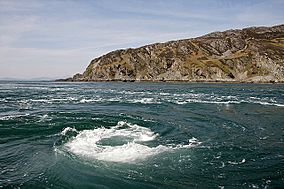Scarba, Lunga and the Garvellachs National Scenic Area facts for kids
Quick facts for kids Scarba, Lunga and the Garvellachs National Scenic Area |
|
|---|---|

The Corryvreckan Whirlpool
|
|

Location and extent of the Scarba, Lunga and the Garvellachs NSA.
|
|
| Location | Argyll and Bute, Scotland |
| Area | 65 km2 (25 sq mi) |
| Established | 1981 |
| Governing body | NatureScot |
Scarba, Lunga and the Garvellachs is a special place in Scotland. It's one of 40 "National Scenic Areas" in the country. These areas are chosen because they have amazing natural beauty. The goal is to protect them from too much building or changes.
This special area includes three islands: Scarba, Lunga, and the Garvellachs. They are all located in a sea area called the Firth of Lorn. The protected area also covers a lot of the sea around these islands. In total, it's about 65 square kilometers. This includes both land and the waters around the islands.
National Scenic Areas are mainly picked for their beautiful views. But they often have other cool features too. These can include interesting history, old buildings, unique rocks, or special wildlife. Many of these areas also have other types of protection to keep them safe.
Contents
Protecting Scotland's Beautiful Places
After the Second World War, people in Scotland wanted to protect their beautiful landscapes. A group was formed to figure out how to do this. In 1945, they suggested protecting five main areas. These were called "national park direction areas." This meant the government could check big building plans in these places.
Later, in 1978, experts looked at landscape protection again. They found more areas that needed special care. The islands in the Firth of Lorn were one of these places. So, in 1981, the "national park direction areas" were changed. They became what we now call "National Scenic Areas." This included the Scarba, Lunga and the Garvellachs area. The boundaries of this special area are still the same as they were first drawn in 1978.
Amazing Landscapes and Sea Views
The islands in this area have very different looks. The Garvellachs are sometimes called the "Isles of the Sea." From some angles, they look sharp and rocky. They have tall cliffs on one side. But closer up, they are green and full of flowers. These islands also have some of the oldest church buildings in Scotland.
Nearby, you can see Lunga and Belnahua. These islands look very different. They have black, shiny rocks from old slate quarries. These quarries used to dig out slate, a type of rock used for roofs.
Scarba is a tall, dark island shaped like a pyramid. It rises high above the other islands. Its top is covered in moorland, which is wild, open land. But on its eastern side, Scarba has many trees. This is a bit surprising for an island in the open ocean.
The sea between these islands is also very exciting. It has some of the strongest tides in the United Kingdom. These strong currents create amazing natural features. One famous spot is the whirlpool in the Gulf of Corryvreckan. It's a huge swirling area of water! There's also a narrow channel between Scarba and Lunga called Bealach a’Choin Ghlais. This means "the pass of the grey dogs."
Wildlife and Sea Creatures
This area is home to many amazing animals, both on land and in the sea.
Birds of Prey
All the islands in this National Scenic Area are part of a "Special Protection Area" for birds. This is because golden eagles live and breed here. These powerful birds of prey need quiet places to raise their young.
Marine Life
The Firth of Lorn waters around the islands are full of wildlife. You might spot huge basking sharks swimming slowly. There are also different kinds of whales and dolphins. Many seals live here too.
The sea floor in the Firth of Lorn has special "reefs." These are not like coral reefs, but they are still very important. They are home to many different kinds of sea creatures. These reefs are considered some of the most diverse in Europe. Many of the animals living here are at the edge of where they normally live. This makes the area extra special. Experts are also thinking about protecting more of the sea here. This would help protect harbour porpoises, which are small whales, even more.

